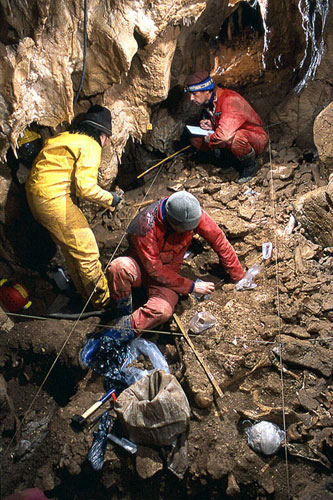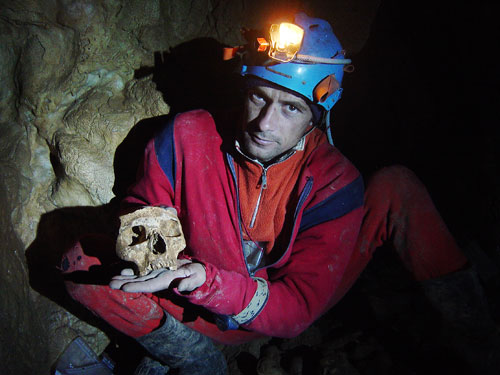Interview with Romanian explorer Stefan Milota
Word file NewScientistText.doc

| |||
Four years ago, Romanian explorer Stefan Milota made an amazing discovery in previously unknown caves deep within his country's Carpathian mountains: a jawbone that turned out to be the oldest modern human fossil found in Europe. More surprisingly, this mandible showed features that suggested early modern humans might have interbred with Neanderthals. With his climbing buddies at the explorers' club Pro Acva Grup, Milota helped scientists make the subterranean trek to Pestera cu Oase (Cave with Bones) for three seasons of dark, 10-hour days, much of them spent climbing, swimming or diving through tight passages. Fredric Heeren followed the cave divers through the underwater passages on one such trip to ask Milota how he found the 35,000-year-old human remains — an hour’s journey deep within a Carpathian mountain.
_____________________________________
When did you start cave diving?
In 1996 I was involved in an ecological project to clean a lake in Romania that was littered with bottles and junk. It was a karstic lake, in which limestone erosion had formed sinkholes and underground streams. At the bottom there was a cave, and I ventured inside. That was my first cave dive. After that I started diving a lot, here in Romanian caves.
And how did you discover the unexplored caves leading to the fossils?
I was with two friends who I had met in the world of climbing, and we were lucky enough to find a part of a karstic cave system in Romania that no one knew about. Most of the caves here were discovered hundreds of years ago. We spent two years exploring and mapping this system. There was a cave where water entered the mountain, and another far away where the water exits. We searched for the junction and found it, and then started finding many branches and galleries. At deeper levels there are submerged passages called sumps, and you need diving gear to explore these.
How did you find the gallery you named Pestera cu Oase?
In February 2002 I dived through a narrow sump about 25 metres long, hoping it might lead somewhere new. It led to a whole new network of caverns. I surfaced in a gallery and walked through until I saw a chimney that went up and up. I climbed a little bit but I was alone and I thought, if I fall, no one will find me. So I came back later with my friend Laurentiu Sarcina. He climbed part way up the chimney and looked up and could see it went way up to near the top of the mountain. He told me, "Wow, there's a big gallery up there." Next time we came with another guy, Adrian Bilgar, and the three of us had all the equipment we needed to climb that chimney. Then we could reach the high gallery.
What did you find there?
At first we only saw a few bones of giant extinct bears, twice as big as today's bears. But then I found a small crack where I felt a current of warmer air. We dug it out and broke some stone around it until we had created a small passage. I kept wriggling further and digging because I knew from the air current that there was something big on the other side. Sure enough, when I pulled myself into the new gallery, I came face to face with three bear skulls. When I stood up, my headlamp showed the whole floor was covered with thousands of bones, partially embedded in the calcite floor.
This gallery had been closed off for a long time?
For thousands of years. The bears walked in from an entrance above, but this caved in long ago. We walked carefully around the bones — some ibex, some giant deer — and then we entered another gallery and I saw a human jawbone. It looked different from a typical human one. It was massive, but I was almost sure that it was human.
How was the jaw positioned?
That was the most bizarre thing: it was resting on top of the calcite floor, not embedded into it like the other bones. That is why most of the archaeologists didn't trust us at first. We searched but didn't find any more human fossils on that visit. We decided to leave the mandible on the cave floor just as we found it. When we came out we called researchers at the Institute of Speleology in Cluj and eventually we were put in touch with the archaeologist Joao Zilhao from the University of Bristol, in England. Joao didn't believe that we had found the skull in that position. He said, "You don't just find human mandibles lying on floors." So he sent Ricardo Rodrigo, an archaeologist based in Lisbon who dives for the Portuguese National Centre of Nautical and Underwater Archaeology, to the fossil cave with us.
How do you explain the position of the mandible?
Finally, just this season, we realised where the mandible came from. Right above where we found it there is a slope. It looks like an animal in recent times had dug a small hole in the sediment there and had displaced the mandible which had rolled down the slope to that strange position.
How old was it?
A small piece of the jawbone was sent for radiocarbon dating. Two labs agreed on a result of about 35,000 years, making it the oldest modern human fossil in Europe.

(photo by Mircea Gherase)
Did you find any more human remains?
Together with Ricardo Rodrigo, we searched the galleries for two weeks, but we didn't find any more human bones until the last day. Then we found the whole face of another skull. That was about midnight. When we came out of the cave Ricardo called Joao on his mobile phone. We all celebrated. No one thinks these are fakes any more. Since then we have provided support for scientists for three field seasons. Now we have an almost complete skull and other bone fragments from a second 35,000-year-old individual. The archaeologists haven't found any torches or tools to show that these people lived in the caves, so it lo0oks like they got washed in from above..
What draws you to spend these long hours climbing and diving in the cold and the dark?
It isn't just for the cave diving. I've spent a lot of time here. Too much. I've lost a girlfriend because of it. People talk about extreme sports, but for me it is not about that. It is about discovery.
Profile
When not climbing or cave diving, Stefan Milota runs Fane Holds in Timisoara, Romania, a company that designs and manufactures climbing holds. After his initial fossil find in Pestera cu Oase, he worked for three years leading scientists into the caves, where he discovered more ancient remains. For this he shared writing credit on several scientific papers. His greatest pleasure still comes from exploring caves, where he hopes he has more discoveries ahead of him.